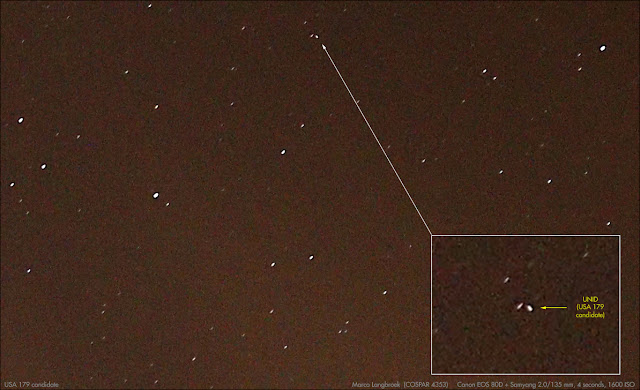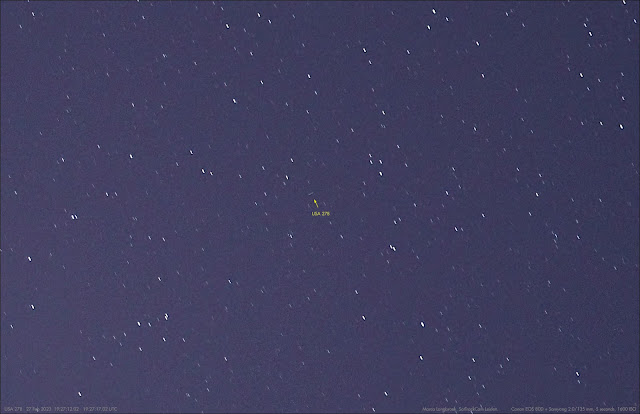 |
| click map to enlarge |
Spring of 2023 seems to be the spring of missile tests. North Korea launched a whole bunch of them, including a Hwasong-17 on March 15. And the USA is testing a number of them: a Hypersonic LHRW test from Cape Canaveral on March 5 that was scrubbed for technical reasons (see my earlier post here): and a now confirmed test of the Hypersonic AGM-183A ARRW on March 13 in the Pacific that does not seem to have gone entirely well either (see earlier post here).
Meanwhile defenses against missiles are being tested too. At least two such Missile Defense tests appear to have been planned for March 2023, judging from Navigational Warnings that have been issued the past weeks.
Mid-March, a Navigational Warning, HYDROPAC 948/23, was issued delineating two hazard zones near Wake island and Kwajalein, in the Pacific, for March 22 (with alternative dates from March 23 to 28) .
They indicate a possible Missile Defense test, likely with a missile fired from Wake island to be intercepted from Kwajalein by a THAAD battery, or vice-versa.
UPDATE 29 March 2023: a press release by Lockheed Martin reveals that this indeed was a Missile Defense test (but not THAAD): an MRBM launched from Wake was intercepted by a PAC-3 (Patriot) missile from Kwajalein.
The two areas from the Navigational Warning are plotted in the map above. The text of the Navigational Warning is below:
131228Z MAR 23
HYDROPAC 948/23(81).
NORTH PACIFIC.
MARSHALL ISLANDS.
WAKE ISLAND.
DNC 12.
1. HAZARDOUS OPERATIONS 222200Z TO 230400Z MAR,
ALTERNATES 2200Z TO 0400Z DAILY
23 THRU 28 MAR IN AREAS BOUND BY:
A. 19-17.00N 166-38.00E, 19-13.00N 166-36.00E,
18-57.00N 166-36.00E, 18-34.00N 166-41.00E,
18-35.00N 166-47.00E, 18-58.00N 166-45.00E,
19-15.00N 166-42.00E, 19-17.00N 166-40.00E.
B. 10-03.00N 167-38.00E, 10-04.00N 167-47.00E,
09-27.00N 167-58.00E, 08-44.00N 167-58.00E,
08-43.00N 167-48.00E, 09-06.00N 167-40.00E.
2. CANCEL THIS MSG 290500Z MAR 23.//
Another Navigational Warning, NAVAREA XII 145/23, has appeared for an area near Hawaii, that indicates a possible Missile Defense test from the Pacific Missile Range Facility at Barking Sands, Kauai, on March 31 (with backup dates on April 1 and 2). Below is the hazard area plotted on a map, and the text of the Navigational Warning:
101835Z MAR 23
NAVAREA XII 145/23(19).
NORTH PACIFIC.
HAWAII.
1. HAZARDOUS OPERATIONS 310530Z TO 311100Z MAR,
ALTERNATE 0530Z TO 1100Z DAILY 01 AND 02 APR
IN AREA BOUND BY
24-00.00N 167-37.00W, 26-22.00N 173-34.00W,
28-08.00N 174-20.00W, 30-40.00N 174-00.00W,
33-04.00N 168-15.00W, 32-24.00N 162-12.00W,
30-01.00N 160-25.00W, 26-00.00N 161-20.00W,
25-56.00N 162-50.00W, 24-26.00N 161-22.00W,
23-26.00N 160-30.00W, 22-29.00N 159-55.00W,
22-03.00N 159-45.00W, 22-02.00N 159-46.00W,
22-11.00N 160-15.00W, 22-45.00N 161-12.00W,
23-35.00N 162-23.00W, 24-50.00N 164-02.00W.
2. CANCEL THIS MSG 021200Z APR 23.//
[see update below this paragraph] I did not find any Navigational Warnings (yet) for the launch of the target, but it is possible that the target is launched from Kauai and intercepted by an SM-3 or SM-6 fired could from a US Navy ship situated in the hazard area northwest of Kauai. Alternatively, a US Navy ship or aircraft could launch the target in or near the area, with the interceptor being launched from Kauai (which has an AEGIS Ashore test facility). Both scenario's have been used in past tests (e.g. here and here).
[UPDATE 29 Mar 2023: The hazard area from NAVAREA XII 145/23 is identical to that for FTM-31 on 29 May 2021 (Navigational Warning NAVAREA XII 241/21), which was a MRBM target launched from Sandia's facility at Barking Sands Kauai, to be intercepted by two SM-6 missiles fired from a US Navy ship north of Kauai. That test failed)
[UPDATE 1 April 2023: now confirmed to be a Missile Defense test and itapperars to have been a re-run of FTM-31. A MRBM target launched from Kauai was intercepted by two SM-6 missiles fired from the US Navy ship USS Daniel Inouye]
Possibly in connection to this test, a number of tracking ships have been sailing out of Pearl Harbor last week, including the MDA's Sea-Based X-Band Radar:
Lots of hardware leaving Hawaii in the last 24 hours - March 22/23, 2023
— WarshipCam (@WarshipCam) March 23, 2023
SRC: webcam / @ES12071207 pic.twitter.com/UpLqgCFsp2



_(cropped).jpg)





